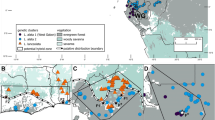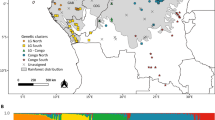Abstract
Hybridization may threaten the conservation status of rare species through genetic assimilation and may confound the ability to distinguish among taxa. We studied these issues in an endangered shrub, Purshia subintegra (Rosaceae), known from four populations growing on limestone outcrops in central Arizona (USA). Using amplified fragment length polymorphisms (AFLP) and the Bayesian clustering algorithm implemented in STRUCTURE, we identified three distinct genetic lineages among Arizona Purshia subintegra and P. stansburiana. An initial split divided San Carlos Basin P. subintegra (considered P. pinkavae by Schaack) from northern P. stansburiana populations (FST = 0.394). A subsequent split separated northern P. stansburiana from two P. subintegra populations at Horseshoe Lake and Burro Creek (FST = 0.207), which comprised a nearly perfect admixture of the two lineages identified in the initial analysis. In the Verde River Valley P. subintegra is sympatric with P. stansburiana and exhibited an average 27% P. stansburiana genes for 5 of 6 stands analyzed, indicating ongoing hybridization and backcrossing with P. subintegra. Individuals carrying >90% P. subintegra markers are identifiable 68% of the time based on morphology, with leaf lobing, leaf size, and leaf length acting as the most reliable indicators of taxonomic status. However, the genetic and morphological distance correlation among individuals was low (r = 0.17, P = 0.0002), indicating that morphology cannot always accurately predict genetic admixture or taxonomy. Overall, our study confirmed the genetic distinctiveness of the San Carlos Basin population, an ancient natural hybrid origin of P. subintegra, and the presence of a hybrid swarm in the Verde Valley, whose conservation value may lie in its heightened genetic diversity.




Similar content being viewed by others

References
Abbott RJ, James JK, Milne RI, Gillies ACM (2003) Plant introductions, hybridization, and gene flow. Phil Trans R Soc Lond Ser B 358:1123–1132
Allendorf FW, Leary RF, Spruell P, Wenburg JK (2001) The problems with hybrids: setting conservation guidelines. Trends Ecol Evol 16:613–622
Anderson JL (1993) A synthetic analysis of a rare Arizona species, Purshia subintegra (Rosaceae). In: Sivinski RM, Lightfoot LL (eds) Proceedings of the southwestern rare and endangered plant conference. New Mexico Department of Natural Resources, Sante Fe, New Mexico, pp 205–220
Baggs JE, Maschinski J (2001) From the greenhouse to the field: cultivation requirements of Purshia subintegra, Arizona cliffrose. In: Maschinski J, Holter L (eds) Southwestern rare and endangered plants: proceedings of the third conference. U.S. Department of Agriculture, Forest Service, Rocky Mountain Research Station, Fort Collins, Colorado, pp 176–185
Bangert RK, Turek RJ, Martinsen GD, Wimp GM, Bailey JK, Whitham TG (2005) Benefits of conservation of plant genetic diversity to arthropod diversity. Conserv Biol 19:379–390
Benham JJ (2001) Genographer Version 1.6.0. Montana State University, Bozeman, Montana
Benson L, Darrow R (1981) Trees and shrubs of the southwestern deserts. University of Arizona Press, Tucson, Arizona
Carney S, Wolf D, Rieseberg LH (2000) Hybridization and forest conservation. In: Boyle TJB, Young A, Boshier D (eds) Forest conservation genetics: principles and practice. CSIRO Publishing, Collingwood, Victoria, Australia, pp 167–182
Cattell MV, Karl SA (2004) Genetics and morphology in a Borrichia frutescens and B. arborescens (Asteraceae) hybrid zone. Am J Bot 91:1757–1766
Daehler CC, Strong DR (1997) Hybridization between introduced smooth cordgrass (Spartina alterniflora; Poaceae) and native California cordgrass (S. foliosa) in San Francisco Bay, California, USA. Am J Bot 84:607–611
Dice LR (1945) Measures of the amount of ecologic association between species. Ecology 26:297–302
Ellstrand NC, Prentice HC, Hancock JF (1999) Gene flow and introgression from domesticated plants into their wild relatives. Ann Rev Ecol Syst 30:539–563
Evanno G, Regnaut S, Goudet J (2005) Detecting the number of clusters of individuals using the software STRUCTURE: a simulation study. Mol Ecol 14:2611–2620
Fernandez-Manjarres JF, Gerard PR, Dufour J, Raquin C, Frascaria-Lacoste N (2006) Differential patterns of morphological and molecular hybridization between Fraxinus excelsior L. and Fraxinus angustifolia Vahl (Oleaceae) in eastern and western France. Mol Ecol 15:245–3257
Fitts RD, Teppedino VJ, Griswold TL (1992) The pollination of the Arizona cliffrose (Purshia subintegra), including a report on experimental hybridization with its sympatric congener P. stansburiana (Rosaceae). In: Sivinski RM, Lightfoot KL (eds) Proceedings of the southwestern rare and endangered plant conference. New Mexico Department of Natural Resources, Santa Fe, New Mexico, pp 359–368
Francisco-Ortega J, Santo-Guerra A, Kim S, Crawford DJ (2000) Plant genetic diversity in the Canary Islands: a conservation perspective. Am J Bot 87:909–919
Henrickson J (1986) Notes on Rosaceae. Phytologia 60:468
Hewitt GM (2004) Genetic consequences of climatic oscillations in the Quaternary. Phil Trans R Soc Lond Ser B 359:183–195
Huang J, Ge X, Sun M (2000) Modified CTAB protocol using a silica matrix for isolation of plant genomic DNA. Biotechniques 28:432–434
Intergovernmental Panel on Climate Change (2007) Working Group I: the physical basis of climate change, Fourth Assessment Report, http://www.ipcc-wg1.ucar.edu/wg1/wg1/-report.html
Kearney TH (1943) A new cliff-rose from Arizona. Madroño 7:15–18
Lau CPY, Ramsden L, Saunders RMK (2005) Hybrid origin of “Bauhinia bladeana” (Leguminosae: Caesalpinioideae), inferred using morphological, reproductive, and molecular data. Am J Bot 92:25–533
Levin DA (2000) The origin, expansion, and demise of plant species. Oxford University Press, New York
Mantel NA (1967) The detection of disease clustering and a generalized regression approach. Cancer Res 27:209–220
Martinsen GD, Whitham TG, Turek RJ, Keim P (2001) Hybrid populations selectively filter gene introgression between species. Evolution 55:1325–1335
Maschinski J, Baggs JE, Quintana-Ascencio PF, Menges ES (2006) Using PVA to examine effects of climate change on the population viability of an endangered limestone endemic shrub, Arizona cliffrose. Cons Biol 20:218–228
McArthur ED, Stutz HC, Sanderson SC (1983) Taxonomy, distribution, evaluation, and cytogenetics of Purshia, Cowania, and Fallugia (Rosoideae, Rosaceae). In: Johnson KL, Tiedemann AR (eds) Proceedings – research and management of bitterbrush and cliffrose in western North America, USDA Forest Service General Technical Report INT-152. Intermountain Forest and Range Experiment Station, Ogden, Utah, pp 4–24
Moody M, Les DH (2002) Evidence of hybridity in invasive watermilfoil (Myriophyllum) populations. Proc Natl Acad Sci USA 99:14867–14871
Mooney HA, Cleland EE (2001) The evolutionary impact of invasive species. Proc Nat Acad Sci USA 98:5446–5451
Mote PW, Hamlet AF, Clark MP, Lettenmaier DP (2005) Declining mountain snowpack in western North America. Bull Am Meteorol Soc 86:39–49
Mount DW, Logan B (1993) Genetic analysis of Purshia subintegra and related Purshia populations by the RAPD marker technique. U.S. Fish and Wildlife Service, Phoenix, Arizona
Oliva-Tejera F, Caujape-Castells J, Navarro-Deniz J, Reyes-Betancort A, Scholz S, Baccarani-Rosas M, Cabrera-Garcia N (2006) Patterns of genetic divergence of three Canarian endemic Lotus (Fabaceae): implications for the conservation of the endangered L. kunkelii. Am J Bot 93:1116–1124
Perry WL, Lodge DM, Feder JL (2002) Importance of hybridization between indigenous and nonindigenous freshwater species: an overlooked threat to North American biodiversity. Syst Biol 51:255–275
Phillips BG, Phillips AM III, Howard DJ (1988) Final report. Starch gel electrophoresis of Purshia subintegra and Purshia stansburiana. Museum of Northern Arizona Report to U.S. Bureau of Reclamation, Phoenix, Arizona
Potts BM, Reid JB (1988) Hybridization as a dispersal mechanism. Evolution 42:1245–1255
Pritchard JK, Stephens M, Donnelly P (2000) Inference of population structure using multilocus genotype data. Genetics 155:945–959
Reichenbacher FW (1994) Identification of Purshia subintegra (Rosaceae). Great Basin Nat 54:256–271
Rhymer JM, Simberloff D (1996) Extinction by hybridization. Ann Rev Ecol Syst 27:83–109
Rieseberg LH (1991) Hybridization in rare plants: insights from case studies in Cercocarpus and Helianthus. In: Falk DA, Holsinger KE (eds) Genetics and conservation of rare plants. Oxford University Press, New York
Rieseberg LH (1997) Hybrid origins of plant species. Ann Rev Ecol Syst 28:359–389
Rieseberg LH, Ellstrand NC (1993) What can molecular and morphological markers tell us about plant hybridization? Crit Rev Plant Sci 12:213–241
Rohlf FJ (2000) NTSYSpc Ver. 2.1: numerical taxonomy and multivariate analysis system. Applied Biostatistics, Port Jefferson, New York
Rojas M (1992) The species problem and conservation: What are we protecting? Conserv Biol 6:170–178
Schaack CG (1987a) Lectotypification of Cowania subintegra Kearney, basionym of Purshia subintegra (Kearney) Henrickson (Rosaceae). Taxon 36:452–454
Schaack CG (1987b) A new Arizona Purshia (Rosaceae). Phytologia 63:301–302
Seehausen O (2004) Hybridization and adaptive radiation. Trends Ecol Evol 19:198–207
Soltis DE, Soltis PS (1995) The dynamic nature of polyploidy genomes. Proc Natl Acad Sci USA 92:8089–8091
Soltis PS, Gitzendanner MA (1999) Molecular systematics and the conservation of rare species. Cons Biol 13:471–483
SYSTAT 10.2 Statistics II (2002) SYSTAT Software Inc. Richmond, California
Tovar-Sánchez E, Oyama K (2004) Natural hybridization and hybrid zones between Quercus crassifolia and Quercus crassipes (Fagaceae) in Mexico: morphological and molecular evidence. Am J Bot 19:1352–1363
Travis SE, Maschinski J, Keim P (1996) An analysis of genetic variation in Astragalus cremnophylax var. cremnophylax, a critically endangered plant, using AFLP markers. Mol Ecol 5:735–745
Travis SE, Proffitt CE, Lowenfeld RC, Mitchell TW (2002) A comparative assessment of genetic diversity among differently-aged populations of Spartina alterniflora on restored versus natural wetlands. Rest Ecol 10:37–42
U.S. Fish and Wildlife Service (USFWS) (1984) Final rule to determine Cowania subintegra (Arizona cliffrose) to be an endangered species. Fed Regist 49:22326–22329
U.S. Fish and Wildlife Service (1994) Arizona Cliffrose (Purshia subintegra) Recovery Plan. USDA Fish and Wildlife Service, Arizona Ecological Services State Office, Phoenix, Arizona, USA
Van Defender TR (1973) Late Pleistocene plants and animals of the Sonoran Desert: a survey of ancient packrat middens in southwestern Arizona. PhD Dissertation, University of Arizona, Tucson, Arizona
Whitham TG, Martinsen GD, Floate KD, Dungey HS, Potts BM, Keim P (1999) Plant hybrid zones affect biodiversity: tools for a genetic-based understanding of community structure. Ecology 80:416–428
Whitham TG, Maschinski J (1996) Current hybrid policy and the importance of hybrid plants in conservation. In Maschinski J, Hammond HD, Holter L (eds) Southwestern rare and endangered plants: Proceedings of the second conference; Gen Tech. Rep RM-GTR-283. U.S. Dept. of Agriculture, Forest Service, Rocky Mountain Forest and Range Experiment Station, Fort Collins, Colorado
Wolf DE, Takebayashi N, Rieseberg LH (2001) Predicting the risk of extinction through hybridization. Cons Biol 15:1039–1053
Acknowledgements
The authors thank J. Busco, D. Callihan, B. Cammack, K. Evans, J. Giguere, T. Martinez, S. Murray, B. Phillips, J. Possley, and P. West for technical support and field assistance. The USDA Forest Service and B. Denham created distribution maps of Purshia subintegra and P. stansburiana and their putative hybrids in the Verde Valley prior to our studies and kindly offered them for our use. This study was funded by the Arizona Department of Transportation to The Arboretum at Flagstaff through the efforts of B. Palmer, G. Ruffner, and D. Bowling and was supported by the Center for Plant Conservation and F. B. McAllister. The use of trade names is for descriptive purposes only and does not imply endorsement by the U.S. Government.
Author information
Authors and Affiliations
Corresponding author
Rights and permissions
About this article
Cite this article
Travis, S.E., Baggs, J.E. & Maschinski, J. Disentangling the role of hybridization in the evolution of the endangered Arizona cliffrose (Purshia subintegra; Rosaceae): a molecular and morphological analysis. Conserv Genet 9, 1183–1194 (2008). https://doi.org/10.1007/s10592-007-9434-8
Received:
Accepted:
Published:
Issue Date:
DOI: https://doi.org/10.1007/s10592-007-9434-8



